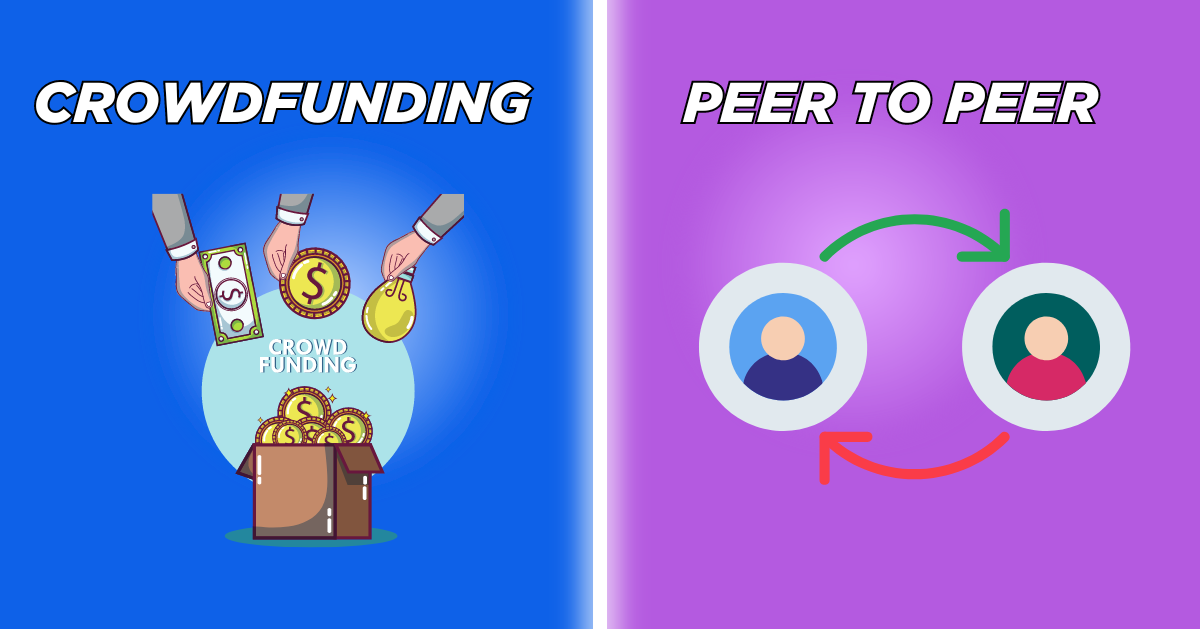In today’s interconnected world, traditional financial models are being redefined by innovative platforms that empower individuals and reshape the landscape of investment and funding. Crowdfunding and peer-to-peer lending have emerged as dynamic channels, captivating the attention of both creative thinkers seeking backing for their ideas and aspiring entrepreneurs yearning for financial support.
By harnessing the collective strength of a vast network of individuals, these platforms revolutionize how people access funds and forge meaningful financial relationships. They offer a fresh avenue for those seeking greater control over their finances and a means to discover new investment opportunities.
In this article, we explore the transformative potential of Crowdfunding vs Peer to Peer Lending, diving into their mechanisms and highlighting the profound impact they can have on individuals and communities alike.
Related Post: How to Sell a Failing Business?
Table of Contents
ToggleWhat is Crowdfunding?
Crowdfunding is a way to collect small amounts of money from many people online to support projects or causes. Regular people can contribute small amounts instead of relying on big investors or banks. Crowdfunding is popular because it allows everyone to help bring great ideas to life. There are different types of crowdfunding.
Types of Crowdfunding
- Donation-based crowdfunding
- Reward-based crowdfunding
- Equity crowdfunding
- Debt-based crowdfunding
Crowdfund for money Requirements
If you want to raise money through crowdfunding, your campaign is everything. No matter your crowdfunding platform, you must build a campaign page or website. It will likely contain the following details:
- Have a clear project idea.
- Choose a suitable crowdfunding platform.
- Create an engaging campaign.
- Set a realistic funding goal.
- Offer attractive rewards.
- Promote your campaign.
- Engage with backers.
- Fulfill your commitments.
What is Peer to Peer Lending
Peer-to-peer lending is when people lend and borrow money from one another without using banks. Lenders have money to invest, while borrowers require money. Lenders decide to select loans to fund after receiving requests from borrowers. It aids borrowers who are unable to obtain loans from banks and allows lenders to make money. However, there are dangers involved as well. Rules can change, and borrowers may not repay. Therefore, do your homework and choose wisely. P2P lending is similar to borrowing money from pals online, but use caution and research.
P2P Lending Requirements
These programs don’t provide you with many opportunities to use your creative or sales talents, they demand fundamental data and paperwork.
- Personal credit rating.
- Business credit rating.
- Annual revenue report.
- Number of years the company has been in business.
Similarities Between Crowdfunding and Peer-to-Peer Lending
Here are the similarities between crowdfunding and peer-to-peer lending:
- Online Money Help: Both crowdfunding and peer-to-peer lending let you get money or invest online. You don’t need a bank to help people or businesses.
- Getting Hard-to-Find Funding: They help individuals or small businesses access money that might be difficult to get from other sources.
- Spreading the Risk: You can invest in or lend money to many different projects or people, which lowers the chance of losing everything and gives you the potential to make more money.
- Supporting What Matters to You: Crowdfunding and peer-to-peer lending allow you to support causes or projects that you care about directly.
- Easy to Use: Thanks to technology, it’s simple to use these platforms. Crowdfunding is like raising money for projects, while peer-to-peer lending is similar to loaning money and earning interest.
Differences Between Crowdfunding and Peer-to-Peer Lending
Understanding the difference can help people to choose the right option for their funding needs because they’re pretty different.
Crowdfunding: the money you receive is usually considered a gift or contribution. You don’t have to pay it back. It is more like a way for people to support your idea and see it come to life. Crowdfunding can involve giving out shares or ownership in a business, which means people might get some financial returns if things go well.
Peer-to-peer lending is like lending money to a friend but on a larger scale. Instead of going to a bank, individuals can lend money directly to others through special websites. So, if you need cash for your business or personal needs, you can borrow from real people who want to help. Then, you have to pay them back with some interest over time, it is just like you would with a traditional loan.
Advantages and Disadvantages of Crowdfunding
Crowdfunding has become increasingly popular to raise funds for various projects, businesses, and personal endeavors. It offers several advantages, but it also has its disadvantages.
Advantages
Crowdfunding has advantages such as:
- Crowdfunding allows entrepreneurs, startups, and creative projects to get money from many people.
- Crowdfunding helps creators test their ideas and whether people like them.
- Crowdfunding campaigns are also a way to promote and market projects.
- Crowdfunding brings people together who support the same project or cause. It creates a community of like-minded individuals.
- With crowdfunding, creators can sell their products or services in advance, even before they are fully ready.
Disadvantages
There are also disadvantages to consider:
- Crowdfunding, you may have to compromise on your project’s vision and decision-making as contributors may have their own expectations and demands.
- Crowdfunding campaigns may not reach their funding goals, which means you might not receive any funds at all.
- It can be challenging to stand out and capture the attention of potential backers.
- Crowdfunding contributors have high expectations, and if you fail to deliver on your promises or face delays, you risk negative feedback, criticism, and harm to your reputation.
- Sharing your innovative ideas or business plans on a crowdfunding platform makes them vulnerable to theft or imitation by unscrupulous individuals or competitors.
Advantages and Disadvantages of Peer-to-Peer Lending
Advantages
Advantages of Peer-to-Peer Lending:
- Accessible loans for individuals and small businesses who may struggle to get credit from traditional banks.
- Lower interest rates compared to traditional loans, saving borrowers money.
- Fast and convenient application process, with online applications and quick loan offers.
- Fair evaluation process based on creditworthiness, ensuring a level playing field.
- Opportunities for investors to diversify their portfolios beyond stocks or real estate.
Disadvantages
Advantages of Peer-to-Peer Lending:
- The lack of strong regulations in the P2P lending industry makes it susceptible to fraud and inadequate credit checks.
- Limited borrowing options, with restrictions on loan amounts and eligibility criteria, make it challenging for some borrowers to access loans.
- Variability in the reliability and stability of P2P lending platforms, potentially causing disruptions in loan transactions.
- Insufficient investor protection compared to traditional banks, could make it difficult to recover funds in case of defaults or platform insolvency.
- Potentially lower interest rates on P2P lending platforms compared to other investment opportunities like stocks or mutual funds.
Conclusion
Crowdfunding and peer-to-peer lending are innovative platforms that revolutionize funding and investment. Crowdfunding allows for collective support without repayment obligations, while peer-to-peer lending involves direct lending and repayment with interest. Both models offer online accessibility, diversification, and support for causes.
Crowdfunding provides access to capital and marketing opportunities but has uncertain funding and fulfillment challenges. Peer-to-peer lending offers easy access to funds and lower interest rates but carries the risk of default and platform vulnerabilities. Understanding these differences helps individuals choose the right option for their funding needs and risk tolerance.










